 Music
Music  Music
Music  History
History 10 Less Than Jolly Events That Occurred on December 25
 Weird Stuff
Weird Stuff 10 Funny Ways That Researchers Overthink Christmas
 Politics
Politics 10 Political Scandals That Sent Crowds Into the Streets
 Weird Stuff
Weird Stuff Ten Bizarre Facts About The Doge Meme
 Our World
Our World 10 Ways Your Christmas Tree Is More Lit Than You Think
 Movies and TV
Movies and TV The 10 Coolest Stars to Set Sail on The Love Boat
 History
History 10 Things You Didn’t Know About the American National Anthem
 Technology
Technology Top 10 Everyday Tech Buzzwords That Hide a Darker Past
 Humans
Humans 10 Everyday Human Behaviors That Are Actually Survival Instincts
 Music
Music 10 Surprising Origin Stories of Your Favorite Holiday Songs
 History
History 10 Less Than Jolly Events That Occurred on December 25
 Weird Stuff
Weird Stuff 10 Funny Ways That Researchers Overthink Christmas
Who's Behind Listverse?

Jamie Frater
Head Editor
Jamie founded Listverse due to an insatiable desire to share fascinating, obscure, and bizarre facts. He has been a guest speaker on numerous national radio and television stations and is a five time published author.
More About Us Politics
Politics 10 Political Scandals That Sent Crowds Into the Streets
 Weird Stuff
Weird Stuff Ten Bizarre Facts About The Doge Meme
 Our World
Our World 10 Ways Your Christmas Tree Is More Lit Than You Think
 Movies and TV
Movies and TV The 10 Coolest Stars to Set Sail on The Love Boat
 History
History 10 Things You Didn’t Know About the American National Anthem
 Technology
Technology Top 10 Everyday Tech Buzzwords That Hide a Darker Past
 Humans
Humans 10 Everyday Human Behaviors That Are Actually Survival Instincts
10 Creative Ways We’ve Gotten Through Wartime Rationing
War is hell. On the home front, civilians have historically been asked to make some pretty drastic adjustments to their lifestyles and diets in order to feed the war machine. Over the years, we’ve found some pretty cool ways of dealing with those adjustments, and some have had a lasting effect which we still feel today.
10Inventing The Twinkie
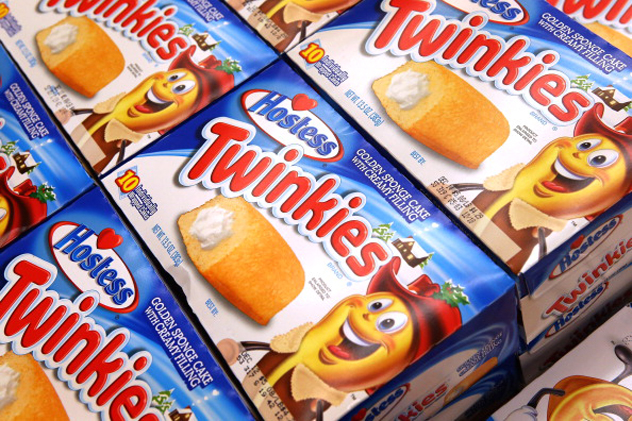
One of the things that was severely limited during World War II in both America and England was the banana—they had to be imported, after all, and that was a luxury that people just couldn’t justify. But it was an extremely popular part of a number of foods, from England’s banana sandwiches to dessert fillings in the States. In England, substitutes like mashed parsnips replaced the banana in sandwiches, but America had an even more creative solution, and it led to the design of one of their most iconic treats.
The original Twinkie had been around since 1930, and the original recipe called for the same spongey cake but with banana-cream filling. Back in the day it was made with real bananas, and that meant that by the time the 1940s hit, there was a massive shortage. The banana was dropped, vanilla cream took its place, and the mascot Twinkie the Kid was introduced. It ended up being such a popular change that even when the banana shortage disappeared, the Twinkie kept its wartime incarnation.
Meanwhile, bananas in Britain were at a premium. A single banana was auctioned off in Russell Square in 1942, ultimately selling for close to $125 in today’s money.
9Liquid Stockings
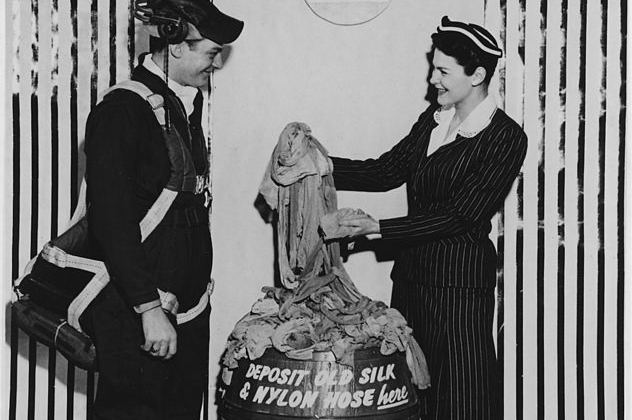
Nylon stockings were a huge deal when they first came out in the late 1930s. Created by DuPont, they were so popular that May 16, 1940—the day they were first widely available in large quantities—became known as Nylon Day. The fashion was short-lived, though, as it was only a year later that nylon was pulled from the production of women’s fashion and moved instead to the production of parachutes, cords, and other wartime necessities like mosquito netting. Women who had already grown accustomed to wearing nylons weren’t happy about having to give up the look, so they found a way of keeping it: They painted it on.
They started using flesh-colored makeup, drawing the seams with an eyebrow pencil. It became so popular that liquid stockings started hitting the shelves in place of stockings. Bottles with names like Leg Silque and Silktona were advertised to contain enough colorant for a few dozen applications. For those who needed a little bit of extra assistance, the women of the Leg Makeup Bars were ready to help. They started popping up in department stores all over, selling products like Leg Sticks, Leg Art, and Stocking Lotion.
8Carrots Instead Of Sugar
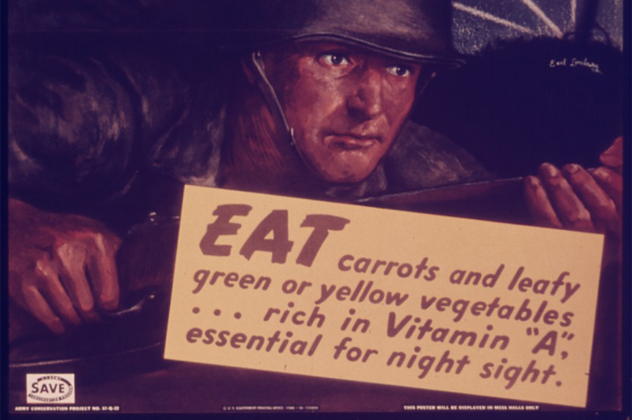
While sugar was a valuable, rationed commodity during the war years, carrots certainly weren’t. England’s Ministry of Food tried to get everyone on the carrot bandwagon, advertising that they were not only good, they were good for you. They even had a mascot that said so: Doctor Carrot. It wasn’t just about eating carrots, though; it was about using them as a replacement for other rationed foods. In December 1941, the Ministry of Food held a competition in which it invited all of Britain’s housewives to submit their recipes for carrots.
The results were overwhelming. There was carrot treacle, carrot pudding, and carrot jam. People were encouraged to replace milk with carrot water. Children found their ice cream replaced by carrots on a stick, and one sweet shop in London started advertising their toffee-dipped carrots as being much, much better than the toffee apples they’d been selling before the war. There was carrot fudge, carrot marmalade, the so-called “cartomel custard,” curried carrots, and even a recipe for mock apricot tarts, which, of course, used carrots instead of apricots.
It was at the same time that carrots were used as the explanation for why British pilots were so good at hitting their targets at night. They claimed that carrots improved vision, which covered up the fact that the Royal Air Force had actually been using the newly invented radar.
7Whale Meat

Whale was explored as an alternative meat source in several countries, but it only took off in Japan. By 1947, about half of the meat consumed in the country was whale, giving a huge boost to a tradition that has long been a part of Japan’s culture. Most school lunches contained whale meat, and it’s had an interesting sort of trickle-down effect on the tastes and eating habits of the people.
According to the Nippon Research Center, older people living in Japan are much more likely to still eat whale meat on a regular basis, as it’s something of a childhood favorite. For those about 30 years old, almost 60 percent of them hardly eat it at all. By the time they looked at people in their teens, about half of them had never even tried it. At the end of the poll, it was found that for about 95 percent of the population, eating whale meat just wasn’t a thing, and that’s a huge swing from even a few decades after the war, when whale made up about a quarter of Japan’s diet.
England attempted to use whale as a substitute for more common types of meat, too, but it never really got beyond the planning stages. By the late 1940s, food testers were being recruited to try whale to see if it was going to be a palatable option. It wasn’t. In fact, National Archive documents say that it was derided by a tester who had spent some of the war years in German-occupied North Africa; he knew what starvation was, and he was also sure that even starving people wouldn’t eat it.
6Wrigley’s Gum And Orbit

By the time World War II hit, chewing gum had been incredibly popular for decades among kids and adults alike. During the war years, there was an incredible shortage of gum in the States for several reasons. Wrigley, the gum manufacturing giant, was running into supply problems just like any number of other companies. They had reserves of gum in storage, but those reserves weren’t meant for domestic use. American soldiers were chewing about 500 million pieces a year, and all of Wrigley’s stockpile was sent overseas.
That left Wrigley in a bit of a quandary for serving their domestic market. They didn’t want to compromise on the ingredients of their tried-and-true staples, so they started making a new wartime substitute for the domestic market—Orbit. It was marketed as the “Good Wartime Chewing Gum,” but it was originally discontinued after the end of the war and the return of the standard Wrigley brands. It did, however, get Wrigley looking at other flavors, and it was ultimately re-introduced in 1976 to the German, Swiss, and Dutch markets.
5Paperback Books

Paper rationing during the war helped establish paperback books as a serious publishing medium. One of the earliest publishers of paperbacks, Penguin, had major success with the release of paperbacks. They were affordable, they were easy to carry, and the world seemed ready for them. The idea of the paperback had been tried before in 16th-century Italy and later with the penny dreadfuls, but those attempts fostered an image of cheap, low-quality books (in both content and production) that weren’t good for much. The Penguin books were much different, and by the time paper rationing through the war years put a stranglehold on publishing, paperbacks were the things to have.
The establishment of paper rationing meant that the paper that was used to print books was ridiculously valuable. In order to make sure publishers were getting the most out of what they were allotted, typography restrictions were put in place. Books needed to have a certain number of words per page, a certain plain formatting when it came to chapter breaks, and needed to fall within the guidelines for margins. Paperbacks were, from the beginning, designed to be pretty simple, and it was easy to make them fit within the typesetting guidelines imposed on the industry. They didn’t have much in the way of the elaborate designs that were often in hardcovers, and they had another distinct advantage—they could be carried by soldiers in the field.
With the popularity of this relatively new form of book, other companies jumped on the bandwagon of publishing paperbacks, setting the tone for the next few decades of publishing.
4Spam
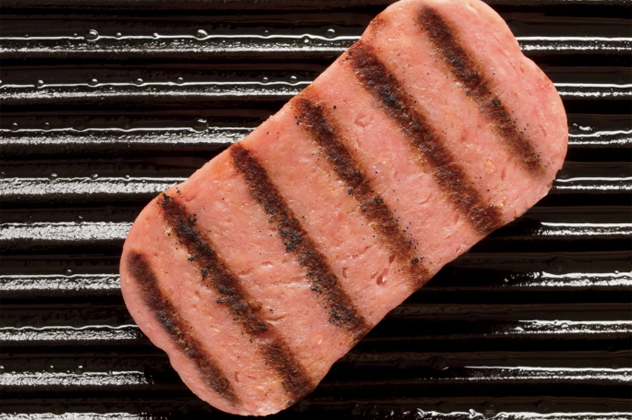
The history of Spam is pretty closely tied to the Great Depression, wartime rationing, and, strangely, the morale of soldiers and civilians alike. Created in the late 1930s, Spam was dubbed the “miracle meat” for its affordability and taste. By 1940, it was in about 70 percent of American households, and once the Lend-Lease program kicked into full swing, it was sent by the ton to Britain and the Soviet Union. Millions of pounds were ultimately sent overseas, and some soldiers ate it for three meals a day. “Spam” became a catchall term for all the canned meat products that were developed during the war, and it wasn’t long before soldiers were bonding over a mutual dread of Spam on the menu.
With meat an incredibly valuable commodity, Spam was a way to use a cut of meat—pork shoulder—that had previously been thrown out. Part of Spam’s success on the home front was also due to the development of the Hormel Girls traveling troupe of salesgirls and singers. After the war, Jay Hormel wanted to do something to boost the job market as well as keep the momentum of his products going. The Hormel Girls started as an all-female, all-veteran group of singing, dancing, instrument-playing ladies who would tour the country in their white Chevrolets, pitching the benefits of Spam at supermarkets during the day and performing on stage in the evening. Although the groups was eventually made up of all professional performers rather than ex-soldiers and wartime nurses, the Hormel Girls were a victorious reminder of just what can be accomplished when a nation puts their mind to it.
3The Black Market
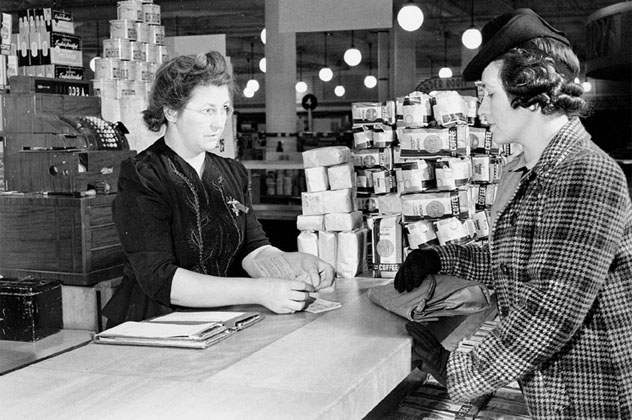
Rationing was touted as a way for people at home to contribute to the war effort and to make a real difference when it came to helping the soldiers on the front lines. But it wasn’t always easy, and one of the ways people got around it was a massive black market on both sides of the Atlantic.
In the States, rationing was controlled by a pretty complicated system of stamps, numbers, and points. Stamps were labeled with a time frame for their use, and every stamp had a point value. So did every food item, meaning that checking out at the grocery store could be a complicated process. Grocery stores themselves were a huge part of the American black market; people were making incredibly good salaries, especially those who were involved with making products for the war effort. Many grocers were willing to completely overlook the stamp requirement if people paid enough in cash, and that meant finding ways around getting stock in. In theory, in order to receive stock, a grocer would have to turn over the stamps that the product was purchased with. But shoppers would often give grocers their unused stamps in return for a favor or two down the road. According to some studies, about 20 percent of businesses had some kind of black market scheme in place.
In England, there were 114,000 instances of prosecution of people who were skirting the rationing laws with black market schemes. One of the most ambitious was a ruse where thieves would simply put on the gear—sometimes nothing more than an arm band—of the Air Raid Precautions wardens and head out to the shops. During a raid, they’d find people more than happy to help them load up a truck full of goods under the pretense that they were simply moving them for safekeeping. Stamps and coupons were also stolen with some regularity. In 1943, five million disappeared in one heist.
2Vegetarian Sausages

In World War I, Germany found itself facing a massive meat shortage that forced the mayor of Cologne to develop something that was, at the time, pretty revolutionary—a meatless sausage. He called it the Kolner Wurst, and most people hated it.
The meat shortage in Germany started because of a decision that, in retrospect, was a little bizarre. In 1915, there was a mass slaughter of Germany’s pigs on the recommendation of a German physiologist. Nathan Zuntz had determined that pigs were presenting a major problem for the German people. They were eating the same food humans were, which made them a drain on the food supply. The end result of his work was the slaughter of about nine million pigs in the spring months of 1915.
It didn’t help the food shortage at all, and it was the mayor Konrad Adenauer who struck upon the idea of making a sausage with more plentiful ingredients like flour, soy, rice, and barley. It’s still debated whether or not his creations were vegetarian or simply had a low meat content that was stretched by grains and vegetables, but he’s still credited with being one of the first to turn Germany’s trademark food, the sausage, from all-meat into something with more vegetarian leanings.
1Imitation Makeup
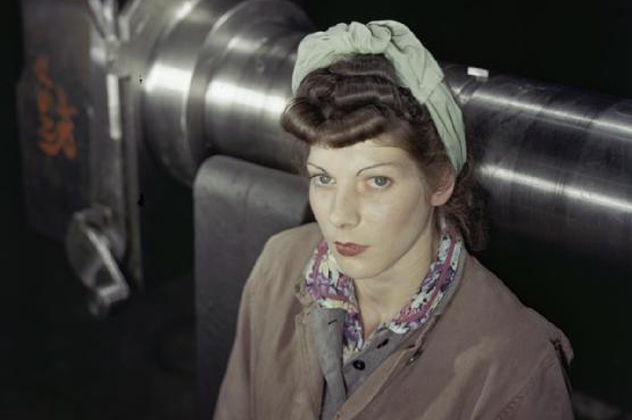
At a time when the government was telling people exactly what they could buy and when, it was undoubtedly easy to feel like there was a huge amount of everyday life that was just beyond control. But one thing that the English government did encourage women to do was to continue to look beautiful. The slogan was “Beauty is Duty,” and while part of it was to boost the morale of the men and women at home, it also served as a taunt in Hitler’s direction. Hitler disapproved of makeup, after all, so it became part of the war effort to find some way to keep women looking powdered and prim.
At first, cosmetic companies were putting out lipstick in colors like Regimental Red and Lips in Uniform, but things became more and more difficult. Due to lack of materials, makeup was sold without applicators and only as refills. Eventually, it was barely being sold at all.
Women needed to start getting creative, so they began using things like beet root juice in place of lipstick. Out of mascara? Use boot polish instead. Face powders and foundations were derived from chalk and margarine. And the large, extravagant hairstyles of the ’40s were no coincidence, either—hats were expensive, not to mention a luxury item now, so hair was designed to take their place. Even if it meant using things like pipe cleaners instead of barrettes, women on the home front were determined not to let war take absolutely everything away from them.








